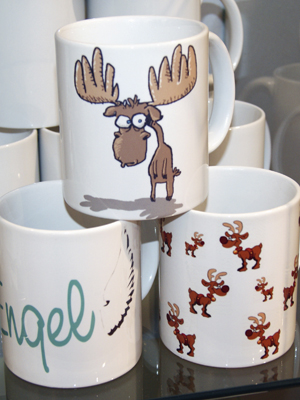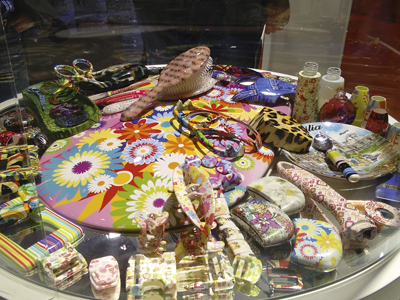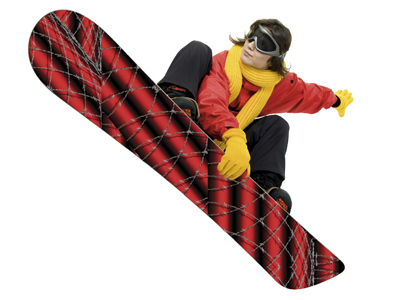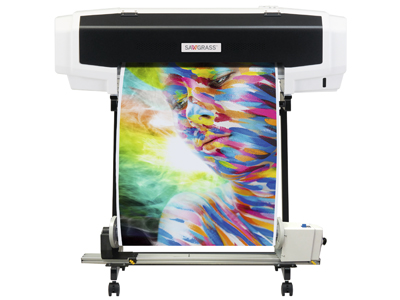Sawgrass’s Virtuoso VJ628 is based on a Mutoh engine, modified to run Sawgrass’s own sublimation inks
Decorating solid objects by direct or transfer printing has a long history. Digitally printed transfers with dye sublimation inks offer a range of add-on possibilities that can be tested quite cheaply, says Simon Eccles.
Dye sublimation offers bright, colourful and permanent water-based inks that can be run in more-or-less standard inkjet printers of all sizes to enable printing onto a range of suitably prepared hard objects. It’s a very easy market to enter, with low cost desktop printers and heat presses readily available from specialist dealers such as i-Sub, Nova Chrome, themagictouch and Charterhouse Xpres. They sell hardware, consumables and specially coated blank materials to decorate. Once you’ve established a market you can easily scale up with larger printers and presses.
Ingrid Van Loocke, channel marketing manager at ink and small format dye-sub printer vendor Sawgrass, says, ‘There are lots of applications for sublimated hard signage. On the grand scale of public exhibitions, large panels featuring key images and designs can double as both an aspect of the decor and a communication tool. ChromaLuxe in particular offers aluminium photo panels in sizes up to 1.2 x 2.4m in a variety of finishes.
‘The possibilities are both beautiful and moving. Images can also be sublimated across multiple panels and floating mounts to create a tiled mural effect. Add in creative lighting and you have a spectacular display that gets attention. From stand-up easels for counter displays, wall placards and directives, to mounted menu panels, sandwich boards and table tops, sublimated hard signage offers value in nearly every industry.’
Sawgrass tends to address the small format end of the inks market. For larger, higher volume applications there are three main suppliers: J-tek, Kiian and Sensient.
Ian McDonald, technical support manager at dye sublimation specialist Nova Chrome UK, describes the process: ‘Sublimation onto solid articles relies on the same process as that of textiles and soft signage – with some variation in equipment and processing parameters to account for the differences in target substrate.
‘Historically, many businesses using the process would concentrate their efforts on textiles and soft signage and largely ignore the smaller format hard substrates – a trend we see shifting. Demand from hobbyists and home businesses has also increased dramatically. We believe that supply of these products nearly equals that for textiles.’
Press here
Dye sublimation transfers are printed onto special coated papers and then applied to the final object in a heat press. Mr McDonald adds, ‘The pressing parameters for these can vary, depending on surface area, depth and density of the item and the heat transfer press used. All of these factors should be considered when taking solid substrates on board, as well as choice of printer. Typical large format printers for sublimation will be optimised for transfer onto textiles, but not hard surfaces – which can hold far more detail, with the result that dot sizes can become an issue. For this reason, desktop systems – and the smaller end of the LFP market, such as the Sawgrass VJ628 – tend to have specific print modes for both hard and soft surfaces.’
The dye sublimation transfer process only works with certain types of plastics, primarily polyester, that absorb and permanently bond with the vapourised ink dyes. Many solids, including wood, metals and ceramics, can be given a thin polyester coating that will accept the dyes.

Mugs like these exmaples personalised by Mimaki are perhaps one of the best known applications for dye-sub onto hard surfaces
Nick Davies, whose company i-Sub sells printers, inks and consumables rather than ‘blanks,’ says that ‘putting the image on is the easy bit. The base raw material is key to the process.’ For example, he says that different coatings are available for metals, depending on whether they need to be flat and durable, or to stretch without cracking when being formed into decorated boxes.
‘Traditionally, hard substrates were primarily the concern of the novelty market, with staples like photo-mugs, coasters and aluminium plates for trophies,’ says Mr McDonald. ‘As the market has matured and the process improved, the range of products has widened dramatically – along with its audience. Today, Nova Chrome supplies a range of clients that span the hobbyist through to large scale operations fulfilling orders for thousands of customers daily.’ The company’s customers include smaller high street shops, promotional houses, signage suppliers, photo-labs and fine art suppliers.
The wide angle
All the wide-format printer makers offer roll-fed dye sublimation models, which are usually lightly modified aqueous or solvent inkjets.
Epson, for example, offers three of its SureColor printers with dye sublimation inks. The 1.1m SC F6200 (nK) costs just under £5000 and is particularly intended for transfers onto solids, says Phil McMullin, sales manager, ProGraphics at Epson UK. ‘We’ve done work with [RIP developer] Wasatch, in combination with ChromaLuxe, to improve the halftone printing and making a dedicated option for hard substrates. What that gives is low levels of graininess, smooth graduations and more vivid colours, well beyond what you might expect from a standard CMYK inkset.’

Epson demonatrated a wide range of sublimation-printed objects at Fespa in May
Epson also makes the SC-F7200 (£10,595) and the faster SC-F9200 (£16,595), both 1.6m models, but Mr McMullin says these are more intended for full-time textile production.
A few years ago specialist dye sublimation dealers often sold basic Epson desktop printers, modified to take dye sublimation inks, often from Sawgrass or Sensient. This seems to be rather less common, with dealers now mostly favouring Ricoh-based desktop packages with Sawgrass or other dye sub inks.
Mimaki has a range of wide format dye sublimation inkjets for either direct or transfer printing. The 1.3m Ts30-1300 is the entry level at £7495, running at up to 19 sqm/hr. UK distributor Hybrid Services says it’s suited to ‘creating sportswear, promotional apparel, samples, and rigid items such as mugs and metal plaques, plus larger transfers for snowboards, skateboards and cycle graphics.’

Snowboard decoration by Mimaki
There are also dye-sub configurations of the JVC printer-cutters, which can be particularly useful for cutting out shaped transfer sheets on-the-fly. The compact CJV1500-75 is an 800mm print-and-cut machine for £6995. A special offer on the 1.6m JVC150-160 is priced at £9495 until 30 September, with an option to add 16 litres of Sb54 dye sub ink with the Bulk Ink System for £1000. The JVC300-160 has a similar offer, with a temporary price of £15,995 and the same ink deal.
Mimaki also makes several 1.8m dye sub printers mainly intended for textile work, plus a big 3.2m model, the JV5-320DS. Duncan Jefferies, marketing manager at Hybrid, says that some of these machines are used for high volume printing of mug transfers.
Mutoh’s entry-level dye-sub printer is the 1.08m DrafStation RJ900XG (£4098 from UK distributor Colourgen) which the company bills as being suited to ‘everyday dye sublimation’ applications. This runs at up to 18.5 sqm/hr.
For more capacity there is the faster 1.6m ValueJet 1624W (£13,619), which can print at 27.5 sqm/hr. A faster 1.6m model, the 1638WX (£20,704) has eight ink channels and can reach 64 sqm/hr with 2x CMYK.
Ricoh makes A4 cut-sheet desktop inkjets, the Aficio SG3110, resold with dye-sub inks through UK specialist dealers such as Xpres and themagictouch. Sawgrass rebadges A4 and A3 Ricoh printers as the Virtuoso SG400 and SG800, running its own SubliJet-HD CMYK ink and bundled with design and print software. Typical prices (in this case themagictouch) are £429 for the SG400 with ink, while the SG800 costs either £1259 with low capacity ink cartridges, or £1324 with high capacity cartridges.
Sawgrass also offers the wider 630mm Virtuoso VJ628, based on the compact Mutoh ValueJet 628 eco-solvent model, modified to run Sawgrass dye-sub inks. As this is an eight channel model it can run either 2x CMYK for speed, or its eight-colour SubliJet-HD Pro Photo XF set with light cyan, magenta and black for smoother photographs, or the SubliJet-HD FLEX set with extra orange, blue, fluorescent pink and yellow. Themagictouch price is £4319.
Roland DG has two dye-sub models, both 1.6m wide, with a choice of running 2x CMYK for speed or eight colours for vibrancy. Texart RT-640 is a £13,749 model running at up to 32.6 sqm/hr with 2x CMYK or 16 sqm/hr with eight colours (CMYK plus light magenta, light cyan, orange and violet). The £19,999 Texart XT-640 is faster at 63 sqm/hr with 2x CMYK or 31 sqm/hr with eight colours (CMYK plus orange, violet and fluorescent yellow and pink). I-Sub resells these, alongside Epson, Mimaki, DGen and EFI Vutek printers.
Hot stuff
Heat presses are the other vital component in dye sublimation. There’s a wide range of sizes and capabilities. Basic hand-operated models cost very little: Nova Chrome sells an A4+ swing-action manual press for just £229. Themagictouch sells larger manual swing head heat presses starting at £1080 for an Adkins 38 x 50cm bed model, up to £1735 for 61 x 43cm.
French maker Sefa offers a wide range of manual and pneumatic presses, which are sold through dealers including Xpres. Prices start around £1595 for a 400 x 500mm manual model. Sefa also makes larger roller models intended for large sheet materials such as coated metal or wood – the largest is the Subclimax 2513, for 255 x 130cm formats, costing £38,595 from Xpres.
The top end of the market is covered by Italian company Monte Antonio, distributed by i-Sub. These include three heavy-duty flatbed presses in several sizes from 117 x 75cm up to a massive 520 x 220cm twin bed model.
With entry costs in the low four-figure range, including the heat press, dye-sub for solid substrates is a particularly easy market to test and could lead to bigger things.
Read the full September issue of Digital Printer here. Subscribe to the magazine for free – register your details here.





